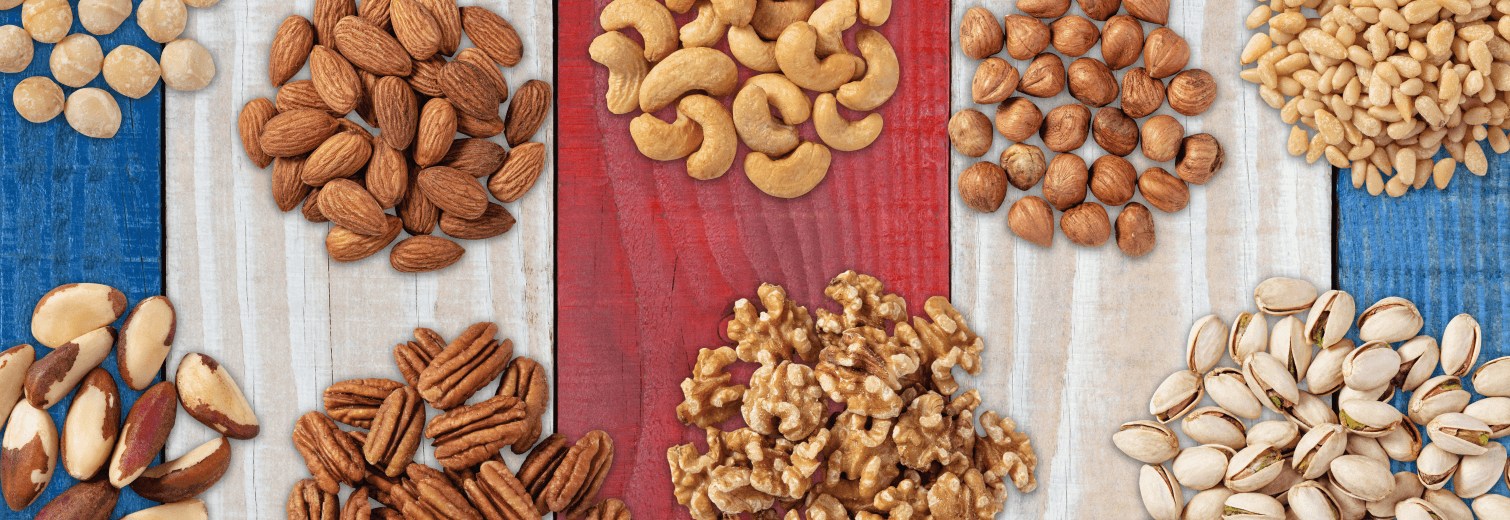Blog

Nuts in American History
Although pecans are the only nut indigenous to the America’s, all tree nuts have become a common ingredient throughout the evolution of American cuisine. Walnuts were first planted by Franciscan monks in the 1700s, and by the 1870s modern walnut production was thriving in Southern California, replicating the nuts native weather of the Mediterranean.
Like the walnuts, Spanish Franciscan padres brought almonds to their Californian missions, but they didn’t thrive in the moist, cool coastal climate. In fact, it wasn’t until crops were planted in the drier inland areas during the next century that the almond industry began to blossom, now supplying more than 80% of the world’s crop.
Hazelnuts have become an Oregonian staple, first planted by an enterprising farmer in the 1850s. Little did he know how perfect the location would be. The Willamette Valley’s ideal blend of temperate climate, rich volcanic soils, and waters flowing from the Cascade Mountains, all come together to create full-flavored hazelnuts sought throughout the world.
Pistachios, originally a Middle Eastern nut, were first planted in the US in 1930s, growing in regions from California to New Mexico. Today California is the largest producer of pistachios in the world.
The native Australian macadamia has become the famous nut of Hawaii, greeting travelers to the tropical state at airports and tourist shops. Introduced in the 1880s, Hawaii was the first region to commercially grow macadamias, fast becoming one of the world’s largest producers.
The American love affair with tree nuts has grown rapidly over the years, particularly now with the popularity of plant-based eating, snacking and an increased awareness of their health benefits. Indeed, there are many US-created dishes incorporating nuts that are now famous around the world. So, this July 4th, wave the American flag and try some of these American classics featuring nuts:
Waldorf Salad – Created at New York’s iconic Waldorf Astoria in 1983 by the hotel Maître d’hôtel, Oscar Tschirky, this salad has evolved over the years, but the classic combination of apples, celery, walnuts and mayonnaise remains constant. Home and restaurant chefs alike in the US commonly grace salads with a dusting of nuts, whether candied, sliced or toasted. Here’s our recipe for Waldorf Salad with a twist.
Pecan Pie – No dessert is more American than the iconic Pecan Pie, with its luscious caramel filling bursting with America’s only native nut. Dating back to the early 1900s and credited as being the South’s most popular pie, pecan pie now appears all over the country with chefs creating their own twist. Other sweet nut treats made popular in the US include carrot or banana bread, oatmeal cookies and candied nuts.
Granola – The first granola (then called granula) dates back to the mid-1800s. Doctors at sanatoriums invented both granola, which is baked, and muesli, which is uncooked. The latter originated in Switzerland and granula (later copied and called granola) in upstate New York. Granula was the world’s first dry, manufactured breakfast cereal. It now takes on many shapes and sizes, nuts and seasonings and can be found in supermarkets around the globe.
Muffins – These small individual “cakes” date back to the late 1800s when baking powder was invented. Nuts were a common ingredient and now you’ll rarely see a café without their own designer muffin.
Nut Crusted Fish – Although it’s really a Mediterranean style of cooking fish, American chefs and home cooks have taken fish and nuts to a new level. Whether it’s a Hawaiian Style Macadamia Crusted Mahi Mahi, a Pacific Northwest Hazelnut crusted Alaskan Salmon, a Jewish Walnut crusted Halibut or Caribbean style mixed nut and cilantro crust, any nut can make a delicious crust for a wonderful flavor and texture boost.
Trail Mix – The first mention of trail mix was in 1910 in an American camping guide. Since then, trail mix has become the “go to” snack for hikers, school lunches, long drives and anyone wanting a healthy grab and go snack.
Bon Appétit and Happy 4th of July!
previous post
Beat the Heat with Cool Nutty Treatsnext post
August is National Sandwich Month!